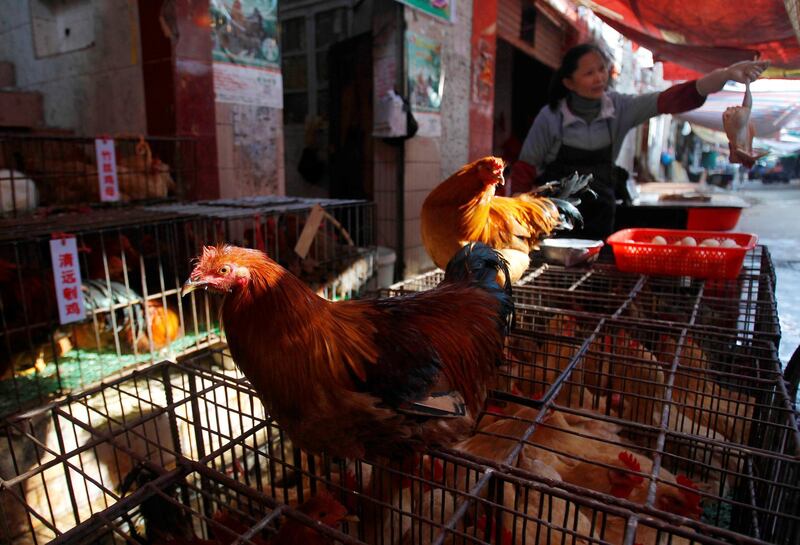China's top poultry producer, Guangdong Wen's Foodstuff, is turning to genetic science to target the country's fast-growing supermarket and fast-food sectors.
Wen's is drawing on an in-house gene bank and breeding unit to create new varieties of meatier chickens for processing at slaughterhouses to better serve restaurant chains and supermarkets, said Wen Pengcheng, a director of the company and its largest shareholder.
That represents a sharp departure from Wen's roots serving local markets, where the animals are sold alive to customers.
"You need a certain weight, the body should look good, the taste must suit people's expectations," he said, describing the chickens the company was aiming for.
If successful, Wen's could start eating into the sales of companies like Fujian Sunner Development that sell broiler chickens bred for their meat efficiency.
Wen's is making the move at a time when its main business, pork, is suffering from a dramatic slump in prices. Net profits in 2017 fell 42.6 per cent to 6.8 billion yuan (Dh3.89bn) on revenues of 55.7bn yuan.
Earnings are set to fall further this year amid an oversupply of hogs in the market. First quarter profits were down 4.4 per cent to 1.4bn yuan, and Wen's shares have lost 15 per cent of their value since the start of the year.
But despite a price/earnings ratio that lags smaller, more specialised peers like poultry processor Fujian Sunner or the pig producer Muyuan Foods, Wen's was big enough to ride out prolonged losses from its pig business, said Chen Lu, analyst at Zhongtai Securities.
"There has always been this cyclical volatility," she said, adding that the poultry unit would help to "flatten" the risk.
Wen's is China's leading producer of native breeds, also known as yellow-feathered chickens, which account for about 40 per cent of the country's poultry market, or 4.7 million tonnes last year.
The slower-growing chickens are preferred over white-feathered broilers bred by global companies for their stronger taste in popular dishes like stewed hen soup, as well as their firmer meat and widely assumed superior nutritional merits.
Wen's plan is to develop native chickens that are meatier as well as being tasty. Some smaller producers of the native birds, like Hunan Xiangjia Animal Husbandry, already have growing sales in supermarkets and online grocers.
Hunan Xiangjia said processed chicken now accounts for more than half of its sales, or about 646 million yuan during 2017.
_______________
Read more:
Starbucks enters fight to be top foreign food player in China
Feathers fly as chicken shortage shuts KFC diners across Britain
_______________
Wen's currently sells about 80 per cent of its poultry, or around 600 million birds a year, live to markets, said Mr Wen.
A shift into retail by the world's fifth-largest poultry company could have a big impact on the market, said Pan Chenjun, senior analyst at Rabobank.
"It will definitely impact white meat, with consumers trading up and looking for better tasting product," she said, referring to the white-feathered chickens.
Wen's has been forced to pay more attention to new sales channels. The habit of buying poultry alive to guarantee freshness has made the company vulnerable to market shutdowns during bird flu outbreaks in recent years.
Almost 300 people died during China's worst ever bird flu outbreak last year, many of them workers in the live poultry trade.
Closed markets and a 30 per cent drop in poultry prices pushed Wen's 2017 profits down by 46 per cent.
Although sales recovered when markets reopened in late spring, markets are expected to face regular closures, with some closing altogether as authorities try to curb the spread of disease.
Demand from such markets will also decline as younger, busy urbanites opt for more convenient food channels.
"If we can't find a solution, yellow chicken consumption will gradually decrease," said Mr Wen.
Building up sales in new markets will take time. China's slower-growing chickens are more expensive to raise than the broilers imported from global genetics firms to supply companies like Yum Brands' KFC and McDonald's China.
Crossing native males with faster-growing females could help them compete in China, according to experts from France's Hubbard Breeders, one of the world's top poultry genetics companies, recently acquired by Aviagen.
But breeding new varieties is an expensive undertaking.
"You may need 10 to 15 years to get somewhere," said Paul van Boekholt, Hubbard's marketing director. He added that another challenge was predicting what the market would want years later.
Sticking to native breeds means it can also avoid the quarantine issues that curbed the imports of breeding chickens needed for white-feathered broilers last year.
Wen's is also looking to France, which has a large retail market for yellow chicken meat, Mr Wen said. Demand for slower-growing chicken is increasing in many European markets because of animal welfare concerns.
While those concerns are not so prevalent in China, local tastes are not easily changed.
"We have to slowly cultivate" the market for chilled yellow chickens, said Mr Wen.
Wen's has four slaughterhouses in Guangdong and Zhejiang, another under construction in Jiangsu, and is seeking locations for new projects, he added.
It also wants to boost sales to fast food chains like Hong Kong's Fairwood Holdings Ltd that already buy yellow chicken meat, and snack food makers.
"The space to grow in the poultry market is still quite large," Mr Wen said.






